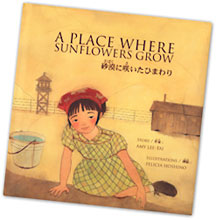READ ABOUT IT
COURTESY CHILDREN'S BOOK PRESS
SAN FRANCISCO, CALIF.,
© 2006 FELICIA HOSHINO
Illustrator Felicia Horino incorporated some of author Amy Lee-Tai's grandmother's compositions in her artwork for the book, "Sunflowers."
|
|
Sowing seeds of hope
"Sunflowers" paints a picture of Japanese Americans in internment camps
The topic of Japanese-American internment was rarely discussed in Felicia Hoshino's home. "Growing up, I was told how painful an experience camp was for my grandparents and that they did not feel comfortable talking about it," she said.
"A Place Where Sunflowers Grow"
By Amy Lee-Tai
Illustrated by Felicia Hoshino
Children's Book Press
2006, $16.95
|
That is one of the main reasons Hoshino chose to illustrate Amy Lee-Tai's book, "A Place Where Sunflowers Grow."
"The book has given me the opportunity to delve into a subject matter rarely spoken of within my family," Hoshino said. "My father was just 2 months old when he, his two older siblings and my grandparents were forced to leave everything they knew."
Her family was interned at the Poston Relocation Camp in Arizona, where they lived for three years, until the end of World War II.
"Now, as I hold my 7-month-old son in my arms, I imagine the uncertainty and fear my grandmother Chizuko must have felt with her 2-month-old son, my father, in her arms as they were swept away on a train not knowing what the future would bring."
Unlike Hoshino, Lee-Tai grew up hearing the stories about the camps and seeing vivid images through her grandparent's artwork.
"Internment was a part of my consciousness from an early age. It used to surprise me when I would meet individuals who had never heard of internment. Now it does not surprise me so much as disturb me -- that an important chapter of American history is still often swept under the rug," Lee-Tai said.
 That lack of knowledge was enough reason for her to write the children's book. "I wanted children, and adults, to know that the internment -- with all of its injustice and hardship -- did in fact happen."
That lack of knowledge was enough reason for her to write the children's book. "I wanted children, and adults, to know that the internment -- with all of its injustice and hardship -- did in fact happen."
While most of the characters and events are fictional, the story was inspired by her family's internment experience and her grandparent's artwork, especially that of her grandmother, Hisako Hibi.
Lee-Tai's grandfather helped establish the Topaz Art School at Topaz Relocation Center. Her grandparents both taught and painted there and her mother and uncle were also students.
"Art brought my mother's family a sense of purpose and peace during a very difficult time in their lives," said Lee-Tai.
"After surviving the internment and my grandfather's subsequent passing not even two years later, my grandmother was left alone and poor to raise two children. She continued to follow her calling to become an artist. I want more people to know about her courageous story, as well as her artwork."
Hoshino said she took inspiration from the paperback book, "Peaceful Painter Hisako Hibi: Memoirs of an Issei Woman Artist" (Heyday Books, 2004, $20), a compilation of Hibi's illustrated diaries. As cameras were not allowed in the camps, Hibi's illustrations provide an essential account of the experience, Hoshino said.
"A Place Where Sunflowers Grow" centers on Mari, a girl who longs to go home. She misses her back yard -- the swing set, sakura tree and colorful flower garden. Her home is now Topaz Internment Camp, a place with a dismal worldview filled with watchtowers, barbed wire and dust storms. In the end, through self-expression and guidance, she learns to find hope.
"I believe the art schools provided an essential environment where artists and fellow internees could go, and somehow be inspired by life in the camps, despite the barbed wire fence and desolate surroundings," Hoshino said.
"I can relate to the joy Mari feels after completing her first drawing and how proud she is presenting her sunflower drawing to the class."
"At Topaz, my grandmother and my mother, Ibuki Hibi Lee, did plant sunflower seeds and my mother attended to them faithfully," said Lee-Tai.
Eventually, the sunflowers grew to the top of the barracks wall. The art students used them as models. "It was a treat to view the sunflowers both in beautiful still lifes and in paintings of them standing tall and strong next to the barrack walls," said Hoshino.
She incorporated some of Lee-Tai's grandmother's compositions into her own illustrations for the book. The intimate moment of a mother bathing her child in Hibi's "Homage to Mary Casset," from 1943, can be found in Hoshino's latrine scene. The same red-dressed figure from "Windy" (1944), struggling to walk across camp in a dust storm, is found in another of Hoshino's illustration.
"Sunflowers" is written in both English and Japanese, which Hoshino hopes will bring the internment experience to the awareness of native Japanese.
Lee-Tai also hopes the story teaches the importance of perseverance, hope and creative outlets.
"I often think about the fragile political situation that other minority groups currently face in our nation," said Lee-Tai. "I hoped to plant a seed in some readers -- to work toward a world that will not commit other atrocities to whole racial/ethnic groups. This is a lofty goal that one book alone won't reach, but I'd like to think that this book will work toward that peaceful end."

